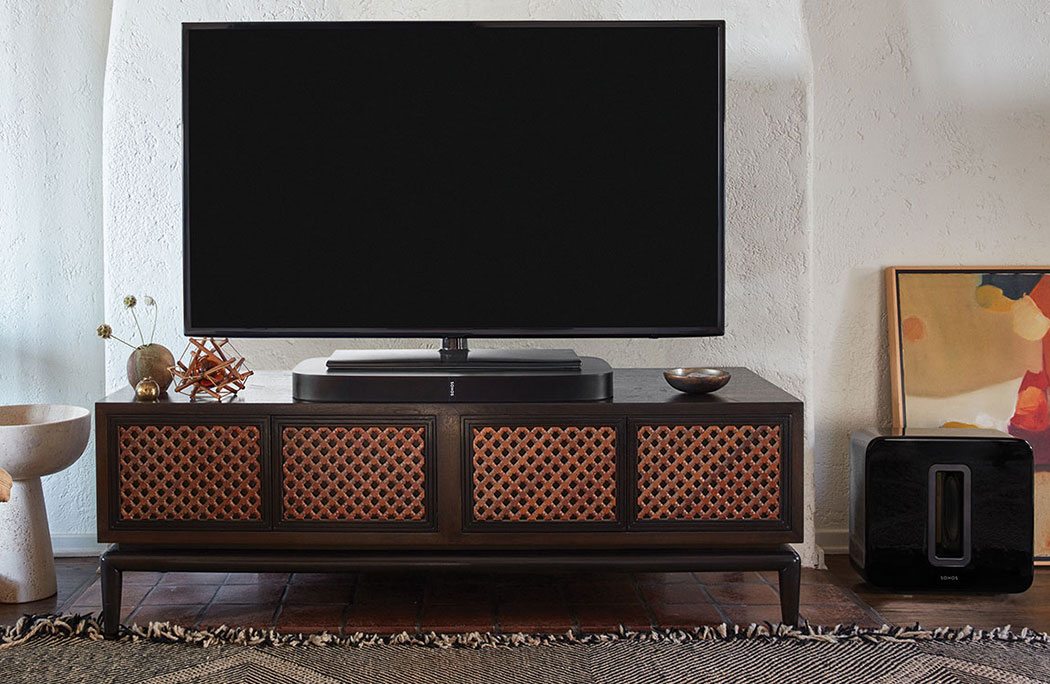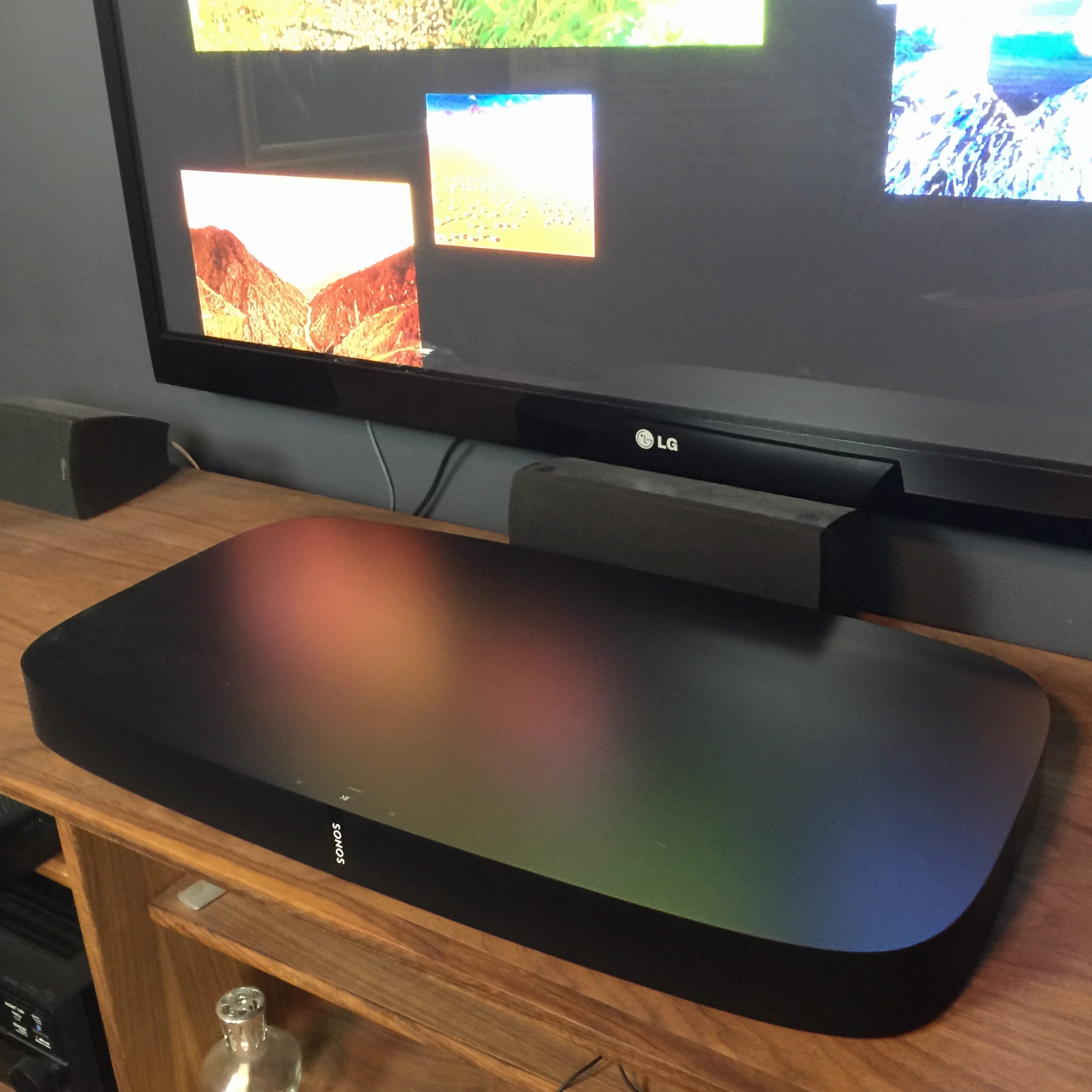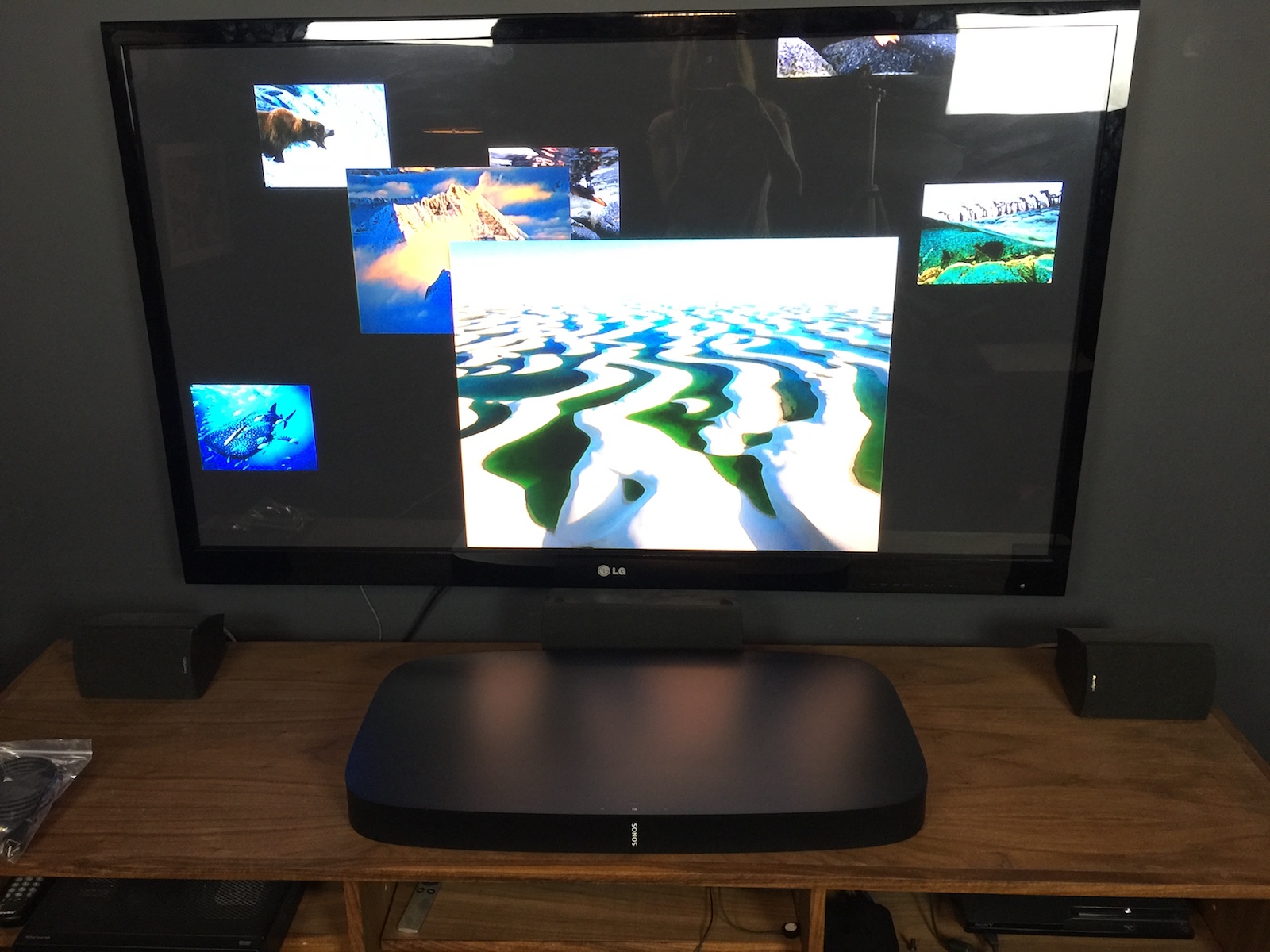
TVs today absolutely need a sound bar or other speakers. The reason is simple; the thinner TVs get, the less space there is to build quality sound capabilities into the television itself. (Read more about this phenomenon, here.)
There’s lots of choice when it comes to what you can add to get proper sound from your fancy flat screen TV; you can build a whole home theatre, or you can go with a sound bar. There’s also a unique offering from Sonos; the Playbase.
What exactly is the Sonos Playbase? It’s not a sound bar…
The Sonos Playbase was not what I was expecting. If you’re imagining some type of sound bar, you’re completely off base… Get it? The Sonos Playbase is much bigger, wider, and heavier than I would have guessed. Far from a narrow sound bar that you can clip to the wall or sit in front of your TV, this device is made to act as a platform for your TV. Sonos’ logic is that since most people never wall mount their TVs and instead have them sitting on furniture, so it makes sense to give people what they want and will actually use, in the way they want to use it. Your TV will sit on top of the Playbase, or straddle it, depending how it’s built.
An off-the-wall approach to better TV sound.
“Typical sound bars work best when wall-mounted directly below a TV,” says Sonos. “Truth is, most TVs end up on stands and furniture – exactly what PLAYBASE was created for. Its low profile design practically disappears beneath your TV, yet it fills your entire viewing room with epic home cinema audio.”
Setting up Sonos Playbase
Setting up the Sonos was simple. Kinda. There are only two cables needed; power and an optical cord sometimes called optical audio, which is included. Optical cable is a very thin fibre-optic cord that you don’t see all that often. You’ll need to make sure your TV has an optical port before you get yourself a Playbase. On my LG TV, it was located right in the back, not in the quick-access panel on the side, so you might need to hunt for it, or check your TV’s manual.
Sonos says in its handout materials that you “won’t even need to read the manual” to get it set up. But it didn’t go so smoothly for me. Though this had nothing to do with Sonos.

Once you have power and the audio cable connected, the Sonos app will walk you through the set-up process. It checks the connection to the TV and will then help you connect to the remote control you use for your television, even if that’s a universal remote.
I went through the set up process and was halfway successful in getting the remote control set up, but during one of the final tests it would not recognize commands from the remote control so I was forced to abandon use of it. Fortunately the Sonos app will still allow me to control the speaker.
I loaded up a program to watch and hit play. But nothing happened. There was absolute silence from the speaker. Pressing the play pause button on the top of the unit I was definitely getting an audio tone from the speaker, but there was no sound coming from the television.
There’s no troubleshooting guide in the Quickstart brochure and I couldn’t find any answers to what was going on online, so I called the customer service phone number for help. Unfortunately, and in my opinion somewhat unwisely, there is no customer service telephone support on the weekends (a time when many people have free time to set up such devices). At this point I was forced to leave the rest of my set up to another day.
The next day I had a bit of an epiphany. I wondered if the set up of my existing home theatre was somehow complicating the Sonos connection. I had turned my television speaker off as the app instructs, but wondered if somehow audio was still being directed to the receiver/amplifier. I disconnected that, and then connected an Apple TV directly to the television set, and voilà! There was audio! (Since I was only borrowing this Sonos unit for a few days, I didn’t want to fully disconnect my existing set up. But that was exactly what I had to do; technology blogger problems, right? If you’ve bought a Playbase for a brand new set up for your home you’ll likely find set-up seamless.)
My advice to people connecting the Sonos system is this; if you have an existing set up, disconnect it completely. You won’t need it with the Sonos connection, and trying to keep it set up will only confuse things.
How does Sonos Playbase sound?
Now it was time to experience the sound. I put on the new Star Trek movie and sat back. In the sweet spot in the centre of the room the Playbase was easily able to fill the space with sound.
My media room is about 12′ x 12′ with an average height (8 foot) ceiling. Even setting the volume at about one third gave it a great room filling sound. Details were crisp, the bass sounded great, and overall it was not super obvious sitting there in the middle of the room that there was only one speaker.
As I walked around the edges of the room to test out the soundscape, I found it was much easier to discern that the sound was coming from the centre of the room and pushing it straight back; at the edges of the room the sound didn’t have that same fullness. But that’s not surprising. And of course it’s easily remedied by adding some additional Sonos speakers (PLAY:1s at the rear and SUB) to create a 5.1 sound system set up.
Packed inside the Playbase are, “ten amplified internal drivers–six mid-range, three tweeters, and one woofer,” which Sonos says can “replace the limited output of your TV’s built-in speakers with deeper booms, crystal clear whispers, and huge waves of sound.”
I was surprised, however, at how good the audio in the room sounded with just the Playbase. If you were just starting out and building yourself a Sonos system, it would be very easy to get away with just having the Playbase until your budget allowed you to add additional speakers; you’d not feel like you were getting ripped off on sound quality.
Where should I place my Sonos Soundbase?
If you’re going to sit your TV on top of the Playbase, Sonos recommends it rest completely on your Playbase with no overhang, and notes it will easily hold any screen up to 77 lbs. For straddle set-ups, feet must be at least 2.3” (58mm) tall to allow for Playbase clearance.
Using the Sonos App for control and streaming
While you can set up and use your own physical remote with the Playbase, you can also use the Sonos app to control it. In fact, you’ll actually need the app to use streaming music or adjust settings and since your initial set up is done through the app, you’re already ready to go. The app is pretty easy to navigate and user friendly, and I’ve got no complaints about it. It will also manage any additional speakers you have on the system.
The app is also how you can access your music library, podcasts or services like Spotify to stream music to the Playbase (which sounds great too!)
Sonos Trueplay tuning for specialized acoustics
All Sonos speakers come with Trueplay tuning. While you can read more in depth about it here, the gist of it is that the app will ‘listen’ to your room and adjust the speaker’s performance to your room’s size, shape and furniture placement for the most optimized sound. I’ve done this in two rooms and I can’t discern a noticeable difference between Sonos on Trueplay, and regular Sonos, but someone with a finer ear than mine might.
Who is the Sonos Playbase for?
The Sonos Playbase is a great first speaker when you are looking to add some quality audio components to your home theatre system. It’s expandable over time and as budget allows meaning it can grow with you and your needs.
The Sonos Playbase is also for people that are using and want to continue having their home theatre set up around a piece of furniture in the living room or media room. It’s not small, so you’ll want to make sure the piece of furniture is substantial and can handle the size of the Playbase (2.28×28.35×14.96 inches or 58x720x380mm)
If you’ve got a wall-mounted TV or other minimalist set up, you’d want to consider some other speaker options instead, as the Playbase is meant to sit on top of a cabinet or larger piece of furniture. It’s also quite heavy, and with the TV set on top will be even more so. Make sure the furniture that you’re planning to use can handle the weight (about 18 lbs or 8.6kg).
Overall thoughts on Sonos Playbase
Despite my tech blogger-specific difficulty getting set up initially, I have no doubt that most people will find this process straightforward and easy. I own a Sonos PLAY;1 and found it simple to set up right out of the box.
I found the app interface very easy to use and all the controls are easily accessible. If I had one complaint about the Sonos app, it’s that I need to run my music through it in order to get it to play on the speaker. With some wireless speakers they can do the work right from your native music app. But that’s nitpicking.
I can’t make a single complaint about the sound of the Sonos Playbase. It easily fills a room with sound and everything from crashing action scenes to the tinkle of broken glass is crisp clear and enjoyable. We enjoyed the Playbase so much in our home that we’ve actually started talking about upgrading our rather antiquated home theater system to a Sonos 5.1 system.
Think this is a great option for expanding your home theater and getting truly great sounding audio from your flatscreen TV.
Sonos Playbase is available at Best Buy in Black or White.



